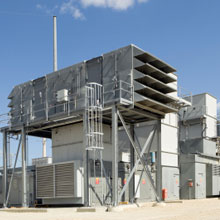Article by Investment U

Gas drillers and other companies are looking with intense interest at CNG-based transport and storage technology.
Pity the poor North Slope of Alaska…
The region produces 600,000 barrels of oil a day, accruing millions of dollars for the state’s treasury as the crude is pumped through the Trans-Alaska Pipeline System. But its 35 trillion cubic feet in natural gas reserves are essentially a wasted resource.
For years, Alaskan authorities hoped a 1,700-mile natural gas pipeline, costing up to $40 billion by some estimates, might be the answer for tapping U.S. energy demand. Alas, gas in the Lower 48 is too cheap, and the pipeline too expensive. The overland-to-Alberta project was scrapped earlier this month. For now, the North Slope’s gas reserves remain in the ground, without a viable way to get to market.
It’s not just Alaska’s problem…
Stranded Gas
A 2007 EIA study concluded that, out of an estimated 6.1 trillion cubic feet of global natural gas reserves, roughly one-half is considered “stranded.” Remote and lightly populated regions like eastern Canada, northern Australia, Vietnam, Indonesia and parts of Russia’s Siberia are all mentioned as having massive reserves of stranded gas.
And then there’s the problem of “associated gas.” That’s the name drillers give for the stuff that comes up the pipe in oil drilling operations. In 2010, one French oil company estimated that 30% of its greenhouse gas emissions – about 15 million metric tons of “carbon equivalent” – were the result of flaring off associated gas at its drill sites. There just isn’t an economical and safe way to do anything else but burn it as a waste by-product.
But new transport and storage technologies for CNG might just offer new answers to these old problems…
Enter the Coselle
Coselle ™ stands loosely for “coiled pipe in a carousel.” It’s being commercialized by Alberta-based Sea NG. What exactly is the system? Imagine a giant hexagonal-shaped garden hose reel, around 50 feet wide and 10 feet tall. Let’s fill that “reel” with 13 miles of tightly wrapped six-inch diameter steel pipe, capable of holding four million cubic feet of compressed natural gas. That’s “a Coselle.”
Still with me? If you stack a bunch of these “Coselles” inside the hull of a specially-built “Coselle Ship,” you have a vessel capable of carrying up to 500 MMcf of CNG.
That’s smaller than what an LNG ship carries. But here’s the trade-off: LNG requires a large technical infrastructure, mainly because of the liquefaction facilities necessary to convert the gas to liquid form. Liquefaction plants are the biggest cost component of any LNG project, with a price tag of up to $4 billion. For those reasons, LNG ships are used mainly for high volume, high-demand shipping routes. CNG ships of the kind envisioned for these new transport technologies are positioned for shorter, lower volume transits of up to 1,200 miles.
So are Coselle-equipped ships the “missing link” to the problem of stranded natural gas? Perhaps. Sea NG is a private firm, but it has two publicly-held heavyweights in pipeline and ocean transport: Enbridge (NYSE: ENB) and Teekay Corp. (NYSE: TK) as investors.
It’s also why gas drillers and other companies are looking with intense interest at this CNG-based transport and storage technology:
- PLN (Indonesia’s state-run power company) signed a deal in January to transport natural gas, via CNG ships, to a peaking plant on the island of Lombok. The first shipments are scheduled tentatively for 2013.
- Centrica Energy (UK) is weighing the use of CNG ships for transport from its gas fields in offshore Tobago. Neighboring Trinidad has an LNG facility, but concerns about its capacity, and the shipping distance for processing, has Centrica looking at CNG instead.
- Husky Energy (Canada) sees CNG as “the leading technology at present” to get natural gas from its fields off Newfoundland, where the company believes it has reserves of 2.3 trillion cubic feet.
Nor is Sea NG the only company out there pushing a CNG solution to the problem of stranded gas. A rival firm, Houston-based EnerSea Transport LLC, has a patented system called VOTRANS ™ which claims to transport larger volumes and lower operating pressures by optimizing the pressure and temperature conditions of the stored gas. EnerSea is backed by a Mitsui & Company Ltd., K Line Shipping (a Japanese shipping giant), Citigroup and Singapore-based Tanker Pacific.
Keep in mind, CNG ships as a concept have been around for years, but always with what’s called a “bottle” design. If you think of a series of immensely tall steel tanks – giant versions of the propane tank in your barbeque grill – that can fit in the hull of a ship, you get the idea. The drawback of a “bottle ship” is the cost and complexity of all the valves and piping, so each tank can be filled and drained, independent of all the others.
These new-generation gas technologies, on the other hand, are designed to make a CNG vessel much cheaper to build and operate. The American Bureau of Shipping, which sets the design, construction and operational standards for marine vessels and offshore platforms, has already approved designs for ships fitted for Coselle and VOTRANS technology. The main question now is when the first of these new ships is commissioned and built to tap into the world’s reserves of stranded gas.
Good Investing,
Jeff Yastine
Article by Investment U